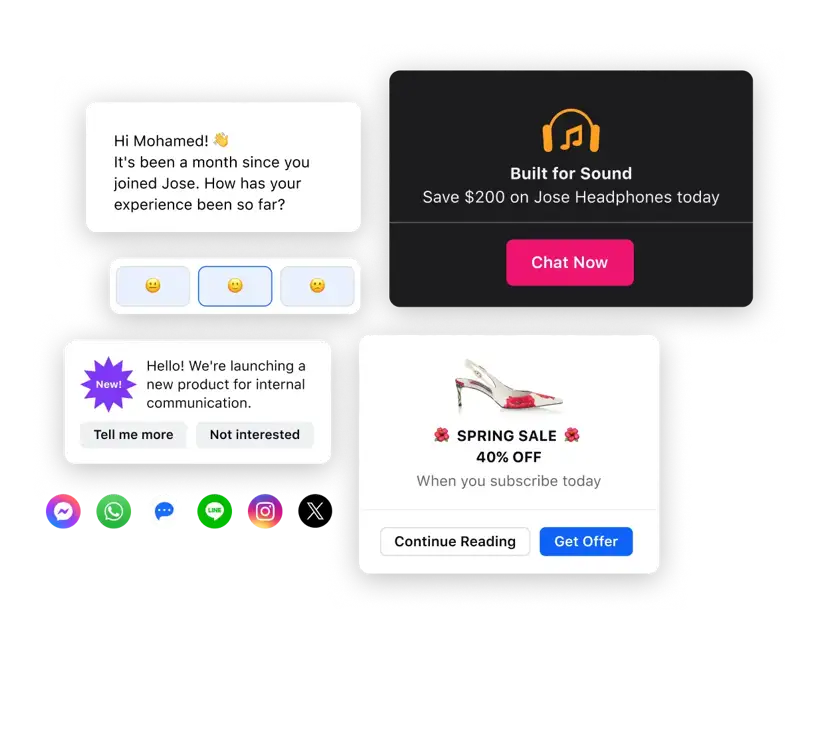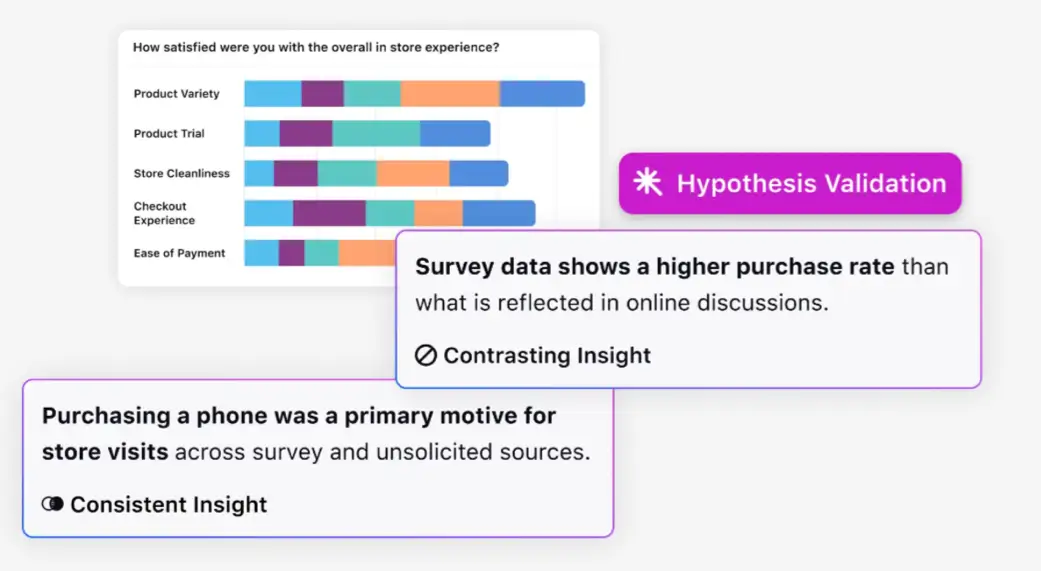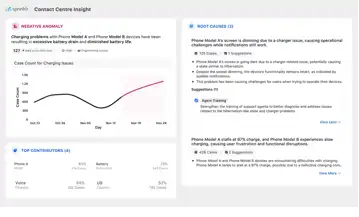The next generation of CCaaS is here
Digital-first customer service, enterprise-scale voice support. Redefine customer service with an AI-powered platform that unifies voice, digital and social channels. Power channel-less interactions and seamless resolution no matter the channel of contact.

Customer Engagement: Top 6 Trends (+ Best Practices)
In 2025, a brand’s perception is increasingly shaped by how it engages with its customers, not just what it sells. With the rapid rise of digital channels, customer expectations have evolved to the point where even WhatsApp has become a frontline platform for customer engagement. That’s how far brands are going to deliver personalized, frictionless experiences.
But let’s be honest — not every brand gets it right. Far too many still mistake blatant promotions for meaningful engagement. And customers are quick to hit “block” or mark them as spam. (Chances are, you’ve done it too.)
Here’s the reality: expecting every engagement to result in a conversion or upsell is outdated thinking. In a world where customers are bombarded with choices and emails, as well as flashy WhatsApp messages, attention is earned, not taken.
So, what does effective customer engagement actually look like in 2025? What trends are shaping the way leading brands build lasting, two-way relationships? And how can your organization implement strategies that genuinely move the needle?
This blog breaks it down.
What is customer engagement in 2025?
Customer engagement is the continuous, real-time orchestration of meaningful, personalized, and proactive interactions across the entire customer lifecycle, from discovery to advocacy. It’s not about selling harder but about connecting smarter.
At its core, customer engagement is about building trust, emotional connection, and value at every touchpoint — web, mobile, live chat, social, email, contact centers, and even immersive channels like AR/VR or voice assistants. The goal is to create a unified, adaptive experience that meets customers not just where they are but where they expect you to be.
6 trends shaping customer engagement in 2025
According to Gartner, over 70% of CX leaders struggle to design strategies that move the needle on loyalty or deliver measurable business outcomes. Because many are still engaging customers based on yesterday’s playbooks.
To build meaningful, trust-based relationships in today’s experience economy, enterprises must adapt to how customers behave, make decisions, and expect to be served. These six trends are defining that shift — and helping leading brands stay ahead of the curve.
1. AI-powered personalization goes real-time and predictive
According to Gartner’s Peer Insights, 98% of organizations have either embedded AI in their customer engagement stack or are actively doing so. The rush is primarily because modern customer engagement needs to be real-time, hyper-relevant, and deeply contextual. And only AI can deliver that at scale.
Today’s AI doesn’t just automate; it orchestrates. It ingests signals from past interactions, behavioral data, real-time usage patterns, CRM insights, and external context (like location or time) to deliver timely, personalized actions that customers want to engage with. Whether it’s dynamic product recommendations, personalized support prompts, or anticipatory nudges — AI bridges the gap between what a customer needs and when they need it.
2. Omnichannel engagement becomes journey-centric
The customer engagement shift is now from channel expansion to journey orchestration. Leading enterprises embrace omnichannel strategies that aren’t just everywhere but are context-aware, seamlessly connected, and customer-intent-driven. Instead of managing isolated conversations, brands are now managing relationships continuously across customer touchpoints.
Here’s what it looks like:
- A customer starts a product query on your website’s live chat.
- Later, they receive a contextual follow-up via WhatsApp while commuting.
- When they call the contact center, the agent already sees the full conversation history across digital and voice channels, with AI surfacing the next best action.
That’s the gold standard: orchestrated, low-effort engagement that follows the customer, not the other way around.
🙂Good to know
Sprinklr’s proactive digital engagement solution helps enterprises put journey-centric engagement into action, enabling teams to connect with customers across pre-sales, sales, and post-sales touchpoints on the channels they prefer.
Built with scalability in mind, Sprinklr also lets you design reusable, AI-driven workflows that can be deployed instantly across 30+ digital channels and in 100+ languages, ensuring consistent, context-aware conversations at every stage of the customer journey. This approach not only enhances responsiveness but also strengthens relationships by meeting customers where they are, with what they need, before they even ask.

3. Engagement that puts customers at the center
Let's circle back to a principle that many brands still overlook: not every customer engagement should aim for a sale. In 2025, the most impactful engagement moments often have nothing to do with revenue and everything to do with value realization.
Put simply: when you make your customer the protagonist of the story — not your product or promotion — you unlock a deeper kind of loyalty.
Enterprise leaders are realizing that customers don't just want features; they want feedback loops. They want to know: How am I doing? What am I achieving? What else can I unlock?
This kind of engagement isn't about nudging or pushing. It's about reflecting customer behavior back to them in a way that creates self-awareness, satisfaction, and momentum.
Take the example of Grammarly's monthly productivity newsletter. These emails aren't selling anything. They're showing users how many words they've written, how often they've been productive, and how their communication compares to others. The communication feels personal and valuable, and it builds habit loops that keep users engaged.
4. Feedback-led customer engagement takes center stage
In 2025, enterprises are shifting from reactive feedback collection to continuous, closed-loop systems that inform not just CX improvements but also product development, campaign design, and frontline service behaviors.
Modern customer engagement strategies embed feedback loops directly into digital journeys —whether it’s a 3-click in-app survey post-chat, a sentiment-driven pop-up after a product trial, or emotion-detection layered into call center transcripts. And customers don’t just want to be heard— they expect to see action taken.
Enterprises that "listen, learn, and loop back" are outperforming. They close the perception gap and turn passive feedback into proactive customer engagement.
Spotify’s Wrapped campaign is a customer engagement masterstroke rooted in user data and behavioral feedback. It celebrates users being themselves while subtly shaping future listening habits. It’s personalized, participatory, and built entirely on feedback.
🎯 Pro Tip
With Sprinklr Surveys, you can centralize customer feedback management across all channels. It combines AI-first feedback management with omnichannel data collection, so you’re not stuck with siloed survey tools or fragmented insights.
By blending structured responses with unstructured data from social media, reviews, and service interactions, Sprinklr provides a 360° view of feedback. And with built-in AI that explains not just what happened but why, your teams can act faster, with confidence.

5. Immersive engagement becomes foundational, not futuristic
In 2025, immersive digital experiences are becoming a core part of how customers explore, interact with, and evaluate brands. As digital-native buyers demand hyper-relevant and real-world contextualization, AI-powered visualization tools are helping close the gap between consideration and conversion.
One standout example is Google’s AI Virtual Try-On, which lets shoppers upload a full-body image and see how clothing from Google Shopping would realistically drape and fit. By blending computer vision, garment simulation, and generative AI, the feature enhances decision-making during the discovery phase — well before the purchase.
This approach leads to increased shopping confidence, longer time spent on platforms, fewer product returns, and stronger engagement with digital-first audiences.
Enterprises across various industries are now reimagining customer experiences by leveraging digital twins, AR-driven product demonstrations, AI-powered configurators, and real-time simulations. These tools are no longer limited to e-commerce — they’re enabling more informed decisions in B2B software, automotive, manufacturing, and complex services as well.
6. Build communities that drive loyalty without asking for it
According to the Global Web Index, people in online groups report feeling a genuine sense of belonging. That’s a clear signal: people don’t just want to consume; they want to connect with peers who share similar interests, identities, and values.
Take the example of Gymshark. The brand, which markets athletic wear, cultivated a culture over the years. From athlete collaborations and tutorials to viral TikTok campaigns like “Change Your Life,” Gymshark built a loyal movement. With over 5 million TikTok followers and engagement rates reaching 18% through micro-influencers, their community is no accident. In fact, it’s designed around relevance, representation, and shared goals.
How customer engagement platforms are engineered today
Modern customer engagement platforms are engineered as cloud-native, microservices-based architectures that prioritize scalability, flexibility, and real-time responsiveness. These platforms unify customer data across every touchpoint into a centralized data layer. This unified data model enables consistent, context-rich interactions, allowing teams to engage with customers while providing complete visibility into past behaviors, preferences, and journey history.
To support real-time engagement at scale, these platforms leverage distributed computing, AI/ML pipelines, and event-driven architecture. Capabilities such as sentiment analysis, intent recognition, and predictive routing are often powered by embedded AI engines that continuously learn from both structured and unstructured data.
On the front end, they offer intuitive agent desktops, omnichannel dashboards, and workflow automation tools — making it easy for both human agents and bots to deliver personalized, efficient service. Integration with enterprise systems, such as CRMs, ERPs, and CDPs, ensures seamless handoffs and end-to-end journey orchestration.
Best practices to implement successful customer engagement strategies
According to Gartner, over 80% of marketing leaders say their companies expect to compete primarily on customer experience. But experience alone isn’t enough. You need to measure what matters and translate those insights into sustained high-impact customer engagement.
Here are foundational best practices that will help you engage smarter, not just louder:
Track the right engagement metrics
Strong customer engagement begins with strong signal detection. This means going beyond surface-level metrics, such as open rates or impressions, which often mask true intent.
Instead, focus on meaningful KPIs mapped to each stage of the customer journey — from acquisition and onboarding to retention and advocacy. These metrics provide a clearer understanding of performance and help prioritize engagement strategies that actually drive results.
Metric | Why does it matter? |
Engagement rate | Measures overall interaction with content or campaigns and tells you what resonates. |
Time on channel | Signals content or service relevance; low times often hint at friction or disinterest. |
Repeat interactions | Indicates interest and relationship depth; high frequency often shows loyalty. |
Gauge emotional tone across touchpoints, especially in support and social. | |
Advocacy/NPS | Reflects long-term relationship health and potential for word-of-mouth growth. |
🔖 Bookmark This: Top 11 Customer Engagement Metrics You Must Track
Use advanced analytics to understand and act faster
Customer engagement is a moving target. Preferences shift. Channels evolve. Issues emerge in real time. The only way to keep pace and stay relevant is to combine real-time visibility with proactive decision-making.
Start with customer journey analytics, which connects the dots across digital, voice, and physical touchpoints to identify friction points, drop-offs, and engagement gaps throughout the customer lifecycle. Then, bring in predictive models to flag at-risk segments and recommend the next best action before the conversation becomes churn.
Layer in unified customer profiles that consolidate data from CRM, service, commerce, and social. When combined with AI-powered orchestration, they enable seamless, personalized interactions across every channel.
💡Do you know
Modern conversational analytics platforms go beyond traditional dashboards. They listen to what customers are actually saying across calls, chats, and social, detecting sentiment shifts, recurring frustrations, and anomalies that might otherwise slip through the cracks. Instead of guesswork, you get root-cause clarity. Instead of firefighting, you can course-correct in real-time.
For enterprises, this means:
- Faster resolution times
- Fewer escalations
- More informed strategies grounded in the voice of the customer’s truth

Automate and scale engagement without losing the human touch
Once you know what’s working and why, the next challenge is delivering consistent, personalized engagement at scale without burning out your teams or overwhelming your systems. That’s where intelligent automation comes in.
Think of automation not as removing the humans but as amplifying them. When powered by AI and fed by unified data, automation can:
- Trigger personalized follow-ups based on behavior or sentiment
- Route conversations to the right agent or bot instantly
- Launch proactive outreach when customers hesitate, stall, or show signs of churn
- Keep the experience consistent across marketing, sales, and service journeys
How 3M reinvented customer engagement at scale
3M, a global innovation powerhouse with operations in over 70 countries, needed a more unified and scalable approach to customer interactions — especially across its vast social media presence. Fragmented moderation efforts and inconsistent response workflows made it hard to deliver timely, brand-aligned experiences.
With Sprinklr’s Unified-CXM platform, 3M consolidated its customer engagement across channels, languages, and business units. The impact was significant:
- Response times dropped by 90%
- SLA performance improved by 75%
- Social moderation scaled across 21 languages
- Teams uncovered high-quality insights and content using Sprinklr’s AI-powered analytics
This shift allowed 3M’s customer-facing teams to move beyond reactive tasks and focus on building stronger, insight-driven connections with their global audience.
The cost of disconnected engagement is too high
In a world where customer expectations evolve faster than enterprise roadmaps, outdated engagement models are more than inefficient; they're dangerous.
Disconnected channels, siloed data, generic touchpoints, and reactive support don’t just cause churn — they erode trust. And trust is the new currency in customer experience.
Here’s the truth: Customers today won’t wait for you to catch up. They expect brands to know them, guide them, and serve them — proactively, contextually, and instantly. To deliver that, you don’t need another tool. You need a unified strategy. Backed by a platform built for enterprise scale.
Why Sprinklr
Sprinklr’s Unified-CXM platform brings all your customer-facing teams, channels, and AI-powered insights into one cohesive system, so you can turn fragmented experiences into seamless journeys.
- Listen and act on real-time signals across 30+ channels
- Orchestrate AI-powered engagement across marketing, care, and sales
- Equip agents with context, not chaos
- Spot churn risks before they escalate
- Move from metrics to meaning with advanced analytics
It’s time to stop guessing and start engaging with clarity, confidence, and precision.
👉 Explore Sprinklr Unified-CXM and see how the world’s leading enterprises are redefining customer engagement, not just reacting to it.
Frequently Asked Questions
Customer engagement today means real-time, two-way interactions across digital touchpoints. It’s no longer about occasional campaigns. It’s about always-on, personalized experiences that guide customers through their journey, before, during and after a sale.
AI analyzes behavior, preferences and past actions to serve what customers want before they ask. It powers dynamic offers, relevant support and timely nudges that feel human. That makes customers feel seen, understood and more likely to stick around.
Focus on engagement rate, customer sentiment, repeat interactions, session time and net promoter score (NPS). Together, these show how often customers engage, how they feel and whether they’ll return or leave.
Yes, if left unchecked. GenAI learns from existing data and if that data reflects biases, it can mirror them in customer interactions. That’s why enterprises must train GenAI on diverse, representative datasets and regularly audit for bias. Use transparent logic, define clear rules for decision-making and apply ethical AI governance frameworks.
Enterprises must use ethical AI, obtain explicit consent and follow global privacy laws like GDPR and CCPA. They must also anonymize data, mask sensitive information and make it easy for users to manage their preferences. Privacy builds trust and trust fuels engagement.
Brand communities turn customers into advocates. They create a space for users to share, learn and connect. This builds emotional loyalty, sparks organic content and drives engagement far beyond the product.



